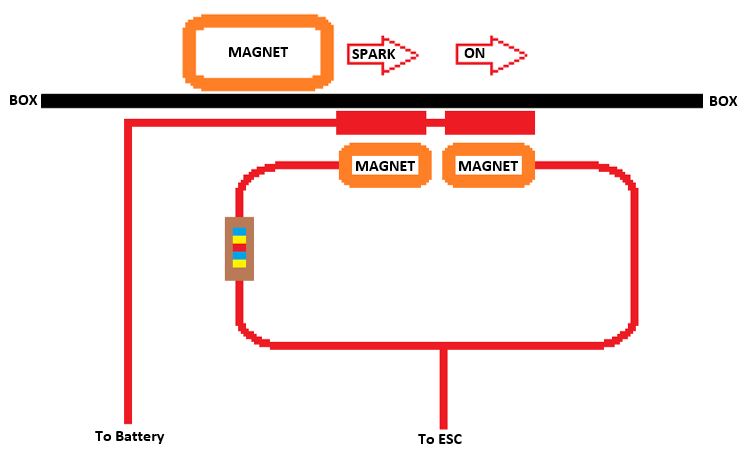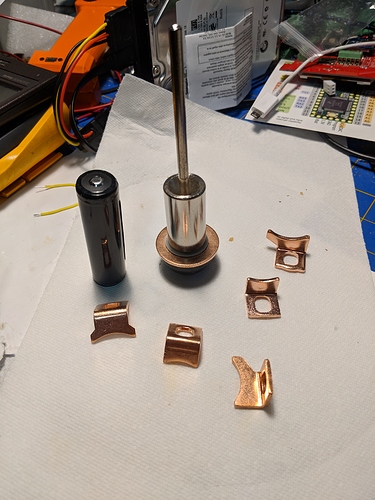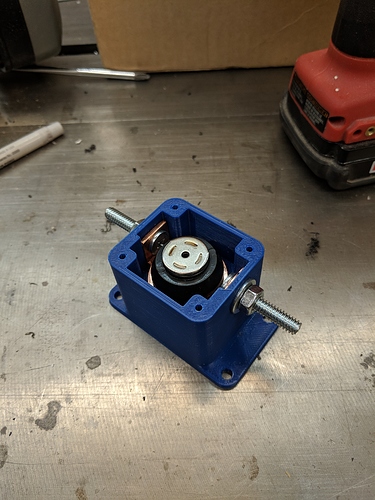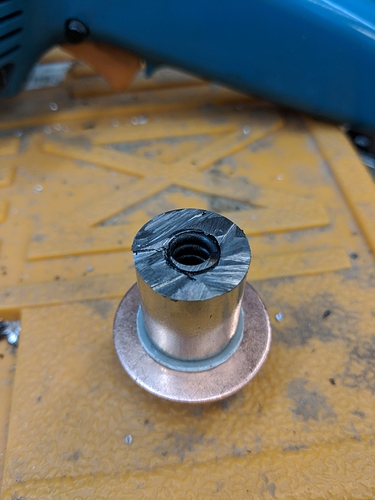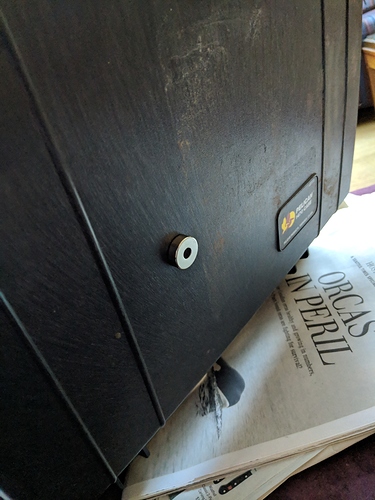Interesting idea. Might rely on too many mechanical parts to be failproof? I bought a used solenoid on ebay (as have others) so am playing with that. Works fine on my bench though It’s a little bulky. 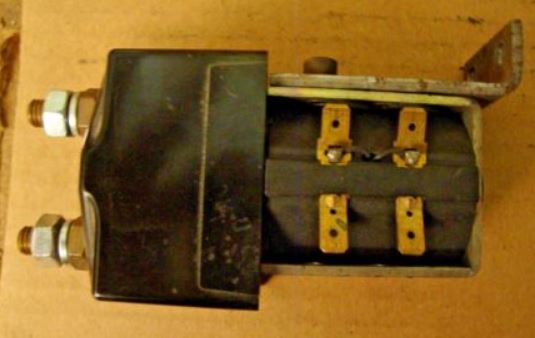
How do you plan to re-arm it?
Getting out of the water to get the board ready again will be a major pain 
I would only see that safety needed if something starts smoking inside. but it seems overkill for when you just fall off… setting you ESC to 0 should be enough.
Has anyone experienced a board running away because the ESC refused to stop when it should have?
You would re-arm it by twisting it back until the spring lock mechanism (TBD) latches and then attach the breakaway strap.
I come from the Esk8 world and I actually have had 2 runaways. The first one was caused by a static hit (not terribly likely on an eFoil) and the second was a code error. Actually both were code errors of some type. So setting the ESC to 0 makes a lot of assumptions about the state of the rest of the system that may not be true. Especially if you get water intrusion.
Ok, I’ve had an even better idea! I’m still thinking about it but basically it consists of a couple of very large copper contacts and a series of neodymium magnets. You’d have the contacts arranged such that when you put a second set of magnets near the first set the contacts close.
In this way the relay-like assembly would be inside the battery box and you’d have a set of magnets in a small housing that you would simply place on the correct spot on the outside of the battery box. Call it a puck.
So no actual contact between the puck and the relay except through the plastic, thus keeping the battery box waterproof. You’d have a puck positioning ring glued to the outside.
The puck would be on a tether. So while the puck is in place contact is made and the magnetic attraction holds the puck in place and keeps the relay turned on. But as soon as you fall off you yank it away and the relay disconnects.
There’s only 2 things I can think of that could go wrong. One is the puck smacking you upside the head when you fall and the other is you’d need some anti-spark at the midpoint of relay contact so that every time you re-armed it it wouldn’t spark and destroy the contact points. Or you could have a bleeder resistor and a hard cutoff. That way the mechanism would be a lot simpler.
[update]
I think I just found all the parts I’d need to do this. Behold, the starter solenoid repair kit.
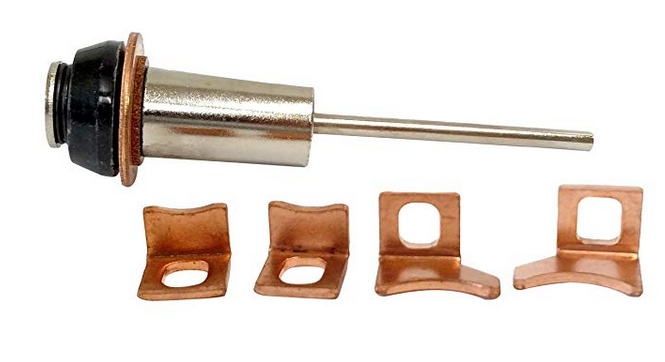
All I need now is some magnets and some quality 3D printer time.
I definitely like your thinking and feel I have yet to see an ideal solution to this problem. My forklift relay is way too bulky. I look forward to hearing more!
Here’s a anti-spark switch capable of holding high continuous current. Just not instock at the moment… https://shop.3dservisas.eu/collections/fatboy/products/fatboy-mini-sparky-switch-50a-200a-100v-pre-charged-anti-spark-switch-with-push-to-start?variant=12506551025757
The problem with anti-spark switches is that they are FET driven and FETS almost always fail short. So if something goes wrong your machine is more likely to stay on than to shut off. Although my eSk8 anti-spark switch (based on Vedder’s) failed off because of water intrusion. But since the device will be on the top of the case if water reaches that level It’s all over already ![]()
I also thought about a reed switch driving a very small relay that drives an automotive starter solenoid, but I’ve seen reed switches stick before. But if the above idea doesn’t work out I’ll try this next.
So the fewer points of failure the better.
I’m going to order some big disk magnets today and hopefully will have a prototype up in a week or 2. the trick will be getting the release spring tension just right. Too little and it might not break connection under full power, and too much and it might lose connection when I bounce off the face of the water or hit a wave.
Thanks for the feedback!
Maybe there could be three positions for a sliding external magnet. The first is off, second engages the anti-spark and the third is on. Something like this…
This is a really good idea. I’ll incorporate it. I might see if I can put the puck down and rotate it rather than slide it in but same same.
Thanks!
I think PacificMeister experiemented with a Reed’s switch?
So far I have been using a small reed switch to cut power to the receiver only. Safer to cut the main power to the esc for sure, good to see the discussion.
It could even be a simple but robust switch, with a flat and smooth profile, under a diaphgram (an old condom etc) for waterproofing, like sorta tumbler switch a household ‘klick-klack’ light switch. A 3-position one? OFF-preload-ON
There needs to be an exterior (water-side) component that is attached to the rider with a tether and pulls away when the rider falls off.
The starter solenoid kit came in, this thing is hefty! Here is a picture for reference with an 18650
I ordered the following magnets:
RC44-N52
RC22CS-P-N52
So it’s not too hard to cut the metal cylinder down and cut off the smaller shaft until the top is completely flat. Then mount it all up in a 3D printed housing.
If the RC44 is strong enough on its own to close then I’ll just go with it. If not I’ll have to add one of the RC22’s to the top of the cylinder.
I can very easily add a small separate copper tab slight off-plane to this thing for anti-spark
The Puck will have the other RC22. I think I’ll put some foam around it.
Next up, model the housing!
Ok, I worked up a housing that, not surprsingly, ended up looking just like a starter solenoid…
I still need to add the terminal for the anti-spark switch and the top (bottom). And in a near thinking foul I thought I’d have to go find just the right release springs until I realized I could just cannibalize a couple of ballpoint pens.
It’s on the 3D printer right now.
Before I print the final rev I might consider integrating a fuse.
I’m looking forward to the outcome! What size will it be?
well, good news and bad news.
The good news is that you can’t possibly overestimate the power of 3D modelling + 3D printing. It was an idea, now it’s a thing:
The bad news is that I now know where the spring insert tunnel stops and I cut right through it.
But not a problem, order another kit, cut an eighth of an inch higher and slightly re-model the housing and I should be in testing in a week.
@sunrise305 including the flange but excluding the nuts it’s 3" wide, 1 3/4" deep and 2" tall.
This is going to work.
I received the magnets and the RC44’s are so powerful that they easily attract through the thickness of the case lid with enough power to spare not only to span the gap and close the contacts, but to put sufficient pressure on the contacts that there is little chance of them disconnecting on impact.
Next up
- JB-weld the magnet to the plunger
- do a final rev of the housing to adjust to the correct height, beef up the mount points and put o-ring channels around each screw boss. I also got some heat-set brass threaded inserts
- integrate anti-spark
- make the outside target for the lanyard
- make the lanyard and figure out how to do the foam surround
I know you’re asking, but Doug, how are you going to get the springs into the housing and then get the magnetic tip of the cylinder through without the springs jumping out and sticking to the magnet?
Well, I didn’t think of that 
